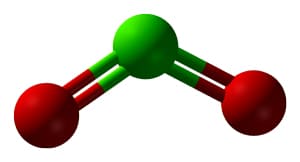
How It’s Used
Chlorine dioxide is a synthetic, green-yellowish gas with a chlorine-like, irritating odor. The compound is quite different from elemental chlorine, both in its chemical structure as in its behavior. For one thing, it remains a true gas when dissolved in water as it does not hydrolyze. For another, it does not form the variety of harmful by-products produced by chlorine, when used for disinfection/sanitation purposes, nor does it persist in the environment.
Chlorine dioxide is used as a biocide in municipal water treatment applications. Likewise, it is employed in industrial water treatment settings, including cooling towers, process water, mill water, and oil and gas water treatment during upstream gas production. It is used to sanitize fruit and vegetables and equipment for food and beverage processing, as well as in life science research laboratories. Chlorine dioxide is utilized to bleach, deodorize, and detoxify a wide variety of materials, including cellulose, paper-pulp, flour, leather, fats and oils, and textiles. The compound also has wide applicability in odor control.
Occupational Health/Toxicology
Chlorine dioxide is a severe respiratory irritant, and may cause bronchospasm and pulmonary edema, which could be delayed in onset. Severe headaches can also occur. Long term exposure may cause chronic bronchitis. The compound can be absorbed through the skin. Chlorine dioxide is a potent irritant to eyes, and may cause a visual “halo effect” around lights.
Full record on chlorine dioxide from Hazardous Substances Data Bank (HSDB), a database provided by the US National Library of Medicine.
The chlorine dioxide entry from NIOSH’s Pocket Guide to Chemical Hazards.
Monitoring Instrumentation
Check out Interscan’s full line of chlorine dioxide gas detection/gas monitoring instrumentation.
